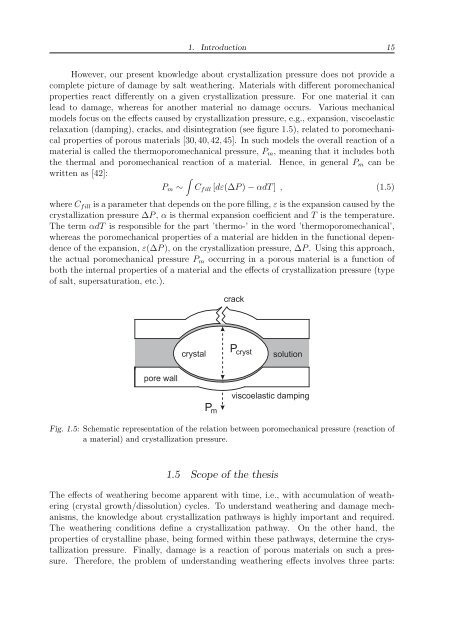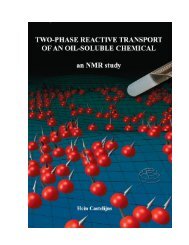P - Technische Universiteit Eindhoven
P - Technische Universiteit Eindhoven
P - Technische Universiteit Eindhoven
You also want an ePaper? Increase the reach of your titles
YUMPU automatically turns print PDFs into web optimized ePapers that Google loves.
1. Introduction 15<br />
However, our present knowledge about crystallization pressure does not provide a<br />
complete picture of damage by salt weathering. Materials with different poromechanical<br />
properties react differently on a given crystallization pressure. For one material it can<br />
lead to damage, whereas for another material no damage occurs. Various mechanical<br />
models focus on the effects caused by crystallization pressure, e.g., expansion, viscoelastic<br />
relaxation (damping), cracks, and disintegration (see figure 1.5), related to poromechanical<br />
properties of porous materials [30, 40, 42, 45]. In such models the overall reaction of a<br />
material is called the thermoporomechanical pressure, P m , meaning that it includes both<br />
the thermal and poromechanical reaction of a material. Hence, in general P m can be<br />
written as [42]:<br />
∫<br />
P m ∼ C fill [dε(∆P ) − αdT ] , (1.5)<br />
where C fill is a parameter that depends on the pore filling, ε is the expansion caused by the<br />
crystallization pressure ∆P , α is thermal expansion coefficient and T is the temperature.<br />
The term αdT is responsible for the part ’thermo-’ in the word ’thermoporomechanical’,<br />
whereas the poromechanical properties of a material are hidden in the functional dependence<br />
of the expansion, ε(∆P ), on the crystallization pressure, ∆P . Using this approach,<br />
the actual poromechanical pressure P m occurring in a porous material is a function of<br />
both the internal properties of a material and the effects of crystallization pressure (type<br />
of salt, supersaturation, etc.).<br />
crack<br />
crystal<br />
P cryst<br />
solution<br />
pore wall<br />
viscoelastic damping<br />
P m<br />
Fig. 1.5: Schematic representation of the relation between poromechanical pressure (reaction of<br />
a material) and crystallization pressure.<br />
1.5 Scope of the thesis<br />
The effects of weathering become apparent with time, i.e., with accumulation of weathering<br />
(crystal growth/dissolution) cycles. To understand weathering and damage mechanisms,<br />
the knowledge about crystallization pathways is highly important and required.<br />
The weathering conditions define a crystallization pathway. On the other hand, the<br />
properties of crystalline phase, being formed within these pathways, determine the crystallization<br />
pressure. Finally, damage is a reaction of porous materials on such a pressure.<br />
Therefore, the problem of understanding weathering effects involves three parts:
















